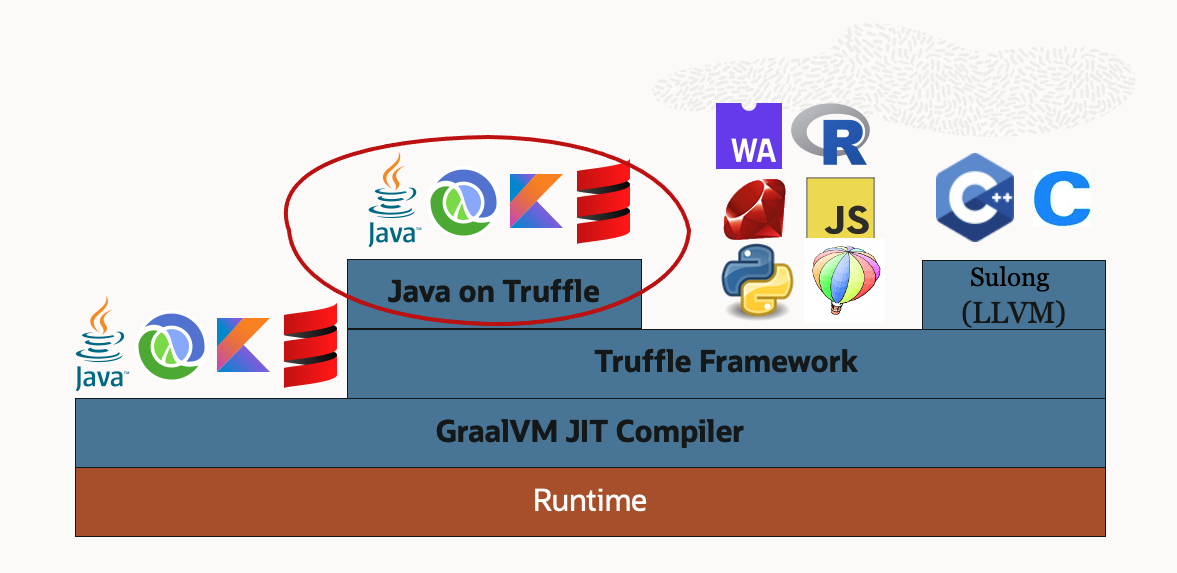GraalVM has released major version 21.0 with a new component, Java on Truffle, that provides a Java Virtual Machine (JVM) implementation written in Java. GraalVM is itself a polyglot virtual machine that provides a shared runtime to execute applications written in multiple languages like Java, Python, and JavaScript.
Prior to this release, running Java applications in GraalVM was possible by using the Java HotSpot VM with the GraalVM Just-In-Time (JIT) compiler, or by compiling to a native executable using GraalVM Native Image. With this release, Java on Truffle, a JVM written in Java using the Truffle framework, provides an additional option to run Java applications.
Java on Truffle, codenamed Espresso, can be installed using the GraalVM Updater, gu. gu is a package manager that downloads and installs packages not included in the core distribution of GraalVM.
gu install espresso
To run a Java application using Java on Truffle, the -truffle option should be passed to the java command.
java -truffle -jar awesomeApp.jar
Java on Truffle is a minified JVM that provides all the core components of a JVM like the bytecode interpreter, the Java Native Interface (JNI), and the Java Debug Wire Protocol (JDWP). It implements the Java Runtime Environment library (libjvm.so) APIs and reuses all the required JARs and native libraries from GraalVM. And just like with a traditional JVM, Java on Truffle supports running other JVM based languages like Kotlin.
Since it is implemented in Java and is able to run Java, Java on Truffle is essentially self-hosted Java or Java on Java. This opens up interesting opportunities to research and innovate the JVM as it allows Java developers to read and understand the JVM source code and improve it.
Here is a list of noteworthy features and benefits provided by Java on Truffle:
- Leverage the enhanced HotSwap capabilities to change methods, lambdas, and access modifiers of classes at runtime during a debugging session.
- Ability to run a version of Java bytecode that is different from the host JVM. For example, a Java 8 only library can be invoked from within a Java 11 application via the Polyglot API.
- Isolate the host JVM and the Java application running on Truffle to sandbox and run less trusted guest code. In this context, the terms host and guest are used to differentiate the different layers where Java is executed. Java on Truffle refers to the guest layer.
- Allow Java applications to directly interoperate with non JVM languages like JavaScript and Python, and pass data back and forth in the same memory space.
- Leverage the standard tools provided by the Truffle framework. For example, the CPU sampler profiling tool can be used to see which part of a Java application takes more CPU time.
- Build an Ahead-Of-Time (AOT) compiled Java native image and dynamically load Java code to run and use Espresso’s JIT compiler. For example, a CI/CD application like Jenkins can be built as a native image while arbitrary plugins can be dynamically loaded.
A collection of demo applications have been provided by GraalVM to showcase these features and benefits.
Note that Java on Truffle is an experimental component and is not ready for production use. And while it is expected that the warmup and peak performance of Java on Truffle will be improved in future releases, the peak performance in this new release of GraalVM is several times slower compared to the regular JVM. Here is a list of noteworthy Java on Truffle limitations that may be addressed in future releases of GraalVM:
- Does not implement the JVM Tool Interface (JVMTI). The corresponding VM options
-agentliband-agentpathare not supported. - Does not implement the
java.lang.instrumentinterface. The corresponding VM option-javaagentis not supported. - Java Management Extensions (JMX) has been partially implemented. Some methods may return partial data.
In addition to Java on Truffle, this release comes with other enhancements. For example, the use of Java serialization in native image binaries is now allowed. The serialization usage configuration can be auto generated with the javaagent prior to building the native image.
This release of GraalVM also comes with some compatibility and runtime improvements across its Ruby, Python, and LLVM distributions. GraalVM’s implementation of the WebAssembly language, GraalWasm, has also been optimized to improve warmup time and overall peak performance of interpreting WebAssembly.
The Java versions in this release of GraalVM community edition are updated and based on OpenJDK 1.8.0_282 and OpenJDK version 11.0.10. The Node.js distribution of GraalVM has been updated to 12.20.1.
On the tools front, GraalVM 21.0 comes with an improved gu tool that allows easy version updates. A GraalVM Extension Pack for Visual Studio Code has also been released to assist in the development and debugging of GraalVM based applications.

